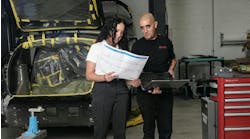The future is now: examining the use of ADAS in electric vehicles
When it comes to the future of vehicles, electric vehicles (EVs) and advanced driver assistance systems (ADAS) are quickly being distinguished as frontrunners of the conversation. Regardless of the source of propulsion, OEMs are racing to outfit these vehicles with the latest and greatest technology and safety features, with the goal of developing self-driving vehicles or autonomous vehicles (AV).
The next generation of ADAS technology will bring enhanced safety to both motorists and pedestrians. However, the level of ADAS technology as it stands is far from the level needed, as is the ability of technicians to properly service vehicles utilizing such systems.
Where do we stand with ADAS and AVs?
To understand this problem, we have to first look at current ADAS systems in today’s vehicles. ADAS is an umbrella term for technologies that are designed to enhance vehicle safety, prevent crashes and ultimately make the motorist's job easier, with features such as automated emergency braking, rear cross traffic and lane change assist bringing vehicles closer to automation. The idea is that these systems not only keep people safe, but in the context of AVs can even contribute to climate efforts by reducing traffic congestion. Most cars on the market today will include some combination of cameras, radar, lidar and ultrasonic sonar. The implementation and success of those systems has been inconsistent at best thus far, and the limitations of the technology are keeping human control as a necessity. Overall, ADAS technology is lagging behind expectations.
Notably, Tesla has avoided the use of lidar and recently stopped implementing radar, though it utilizes other aspects of ADAS technology. The recent eight car pile-up in San Francisco caused by a Tesla with self-driving ADAS systems that malfunctioned, including lane change assist and automated braking, points to some concerns around this technology and its use in vehicles. ADAS systems do not have a universal standard, and as such, the types of systems onboard vehicles are inconsistent. The technology is also being implemented before optimal functionality - simply to keep up with consumer demand.
Although autonomous technology is what is being worked toward in the future, it does already exist in some forms today. Tesla’s recent mishaps clearly show that while vehicles are becoming more advanced, the dependability of our current technology for fully automated driving is far from reality. The application of ADAS in vehicles is an enticing prospect, and one that has dominated the news for the last few years. As vehicles continue to advance rapidly, the ability to properly use and repair ADAS tech is lagging.
The human element
At the end of the day, we don’t yet have the capabilities to build a fully autonomous vehicle. There is not yet technology or computer processing power to supersede the human brain. While there have been significant advancements in ADAS systems in recent years, motorists can still outthink self-driving cars in many situations. When talking about where we currently stand with ADAS and AVs, it is important to consider the human element and remember that keeping people safe is the reason for developing this technology in the first place. To keep up with demand, today’s vehicles are being outfitted with the newest ADAS technology. However, these are being tested and developed faster than technicians can keep up. While many of the new ADAS systems do provide a significant increase in motorist safety, they are not working together closely enough to provide a fully automated driving experience. Yet some manufacturers are pushing that message and are essentially testing their products on the backs of the motorists.
Most technicians aren't currently prepared to service these advanced vehicles in their shops and there’s hesitation to service ADAS due to concerns of liability, lack of space or unaffordable equipment requirements. As ADAS features are integrated into vehicles, once-simple repairs demand increased precision and focused training for the technician to properly service vehicles to ensure the ADAS systems work as designed.
Another current challenge is dealing with assumptions around this technology that sets repair shops up for failure. Motorists may not consider consistent vehicle maintenance as important because of new vehicle technology. Many assume that ADAS systems will ensure vehicle safety and upkeep and not be proactive in following the manufacturer’s maintenance schedule. Also, performing simple services such as a wheel alignment without considering the calibration of the steering angle sensor can create an inaccurate assumption that the ADAS computers can’t overcome. With the ADAS systems onboard, everything is more interconnected than ever before. If anything is misaligned by even one degree, it becomes dangerous for the motorist. ADAS systems are designed for safety, but if technicians do not know how to properly service vehicles with ADAS capabilities, they’re ultimately creating more risk for the motorist.





